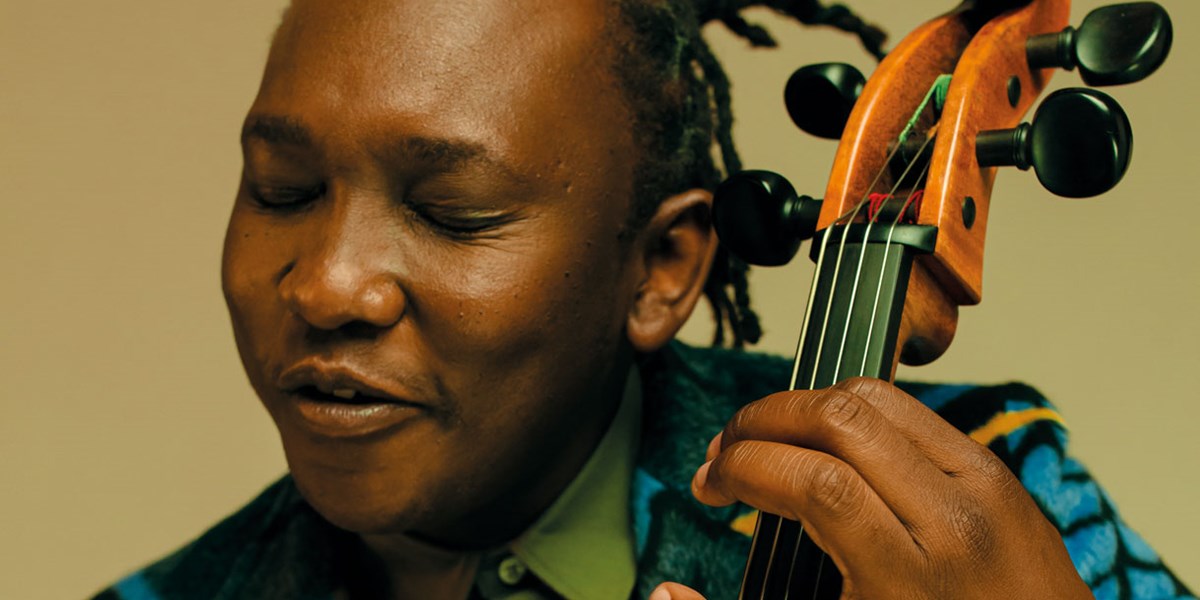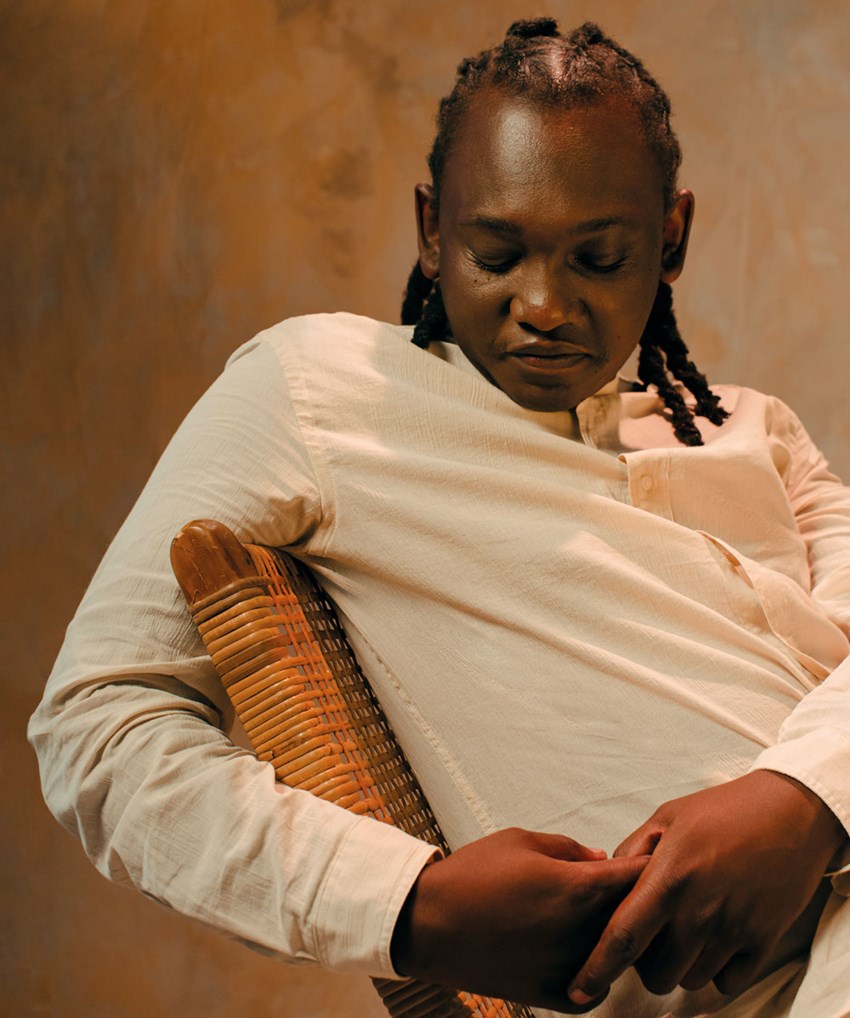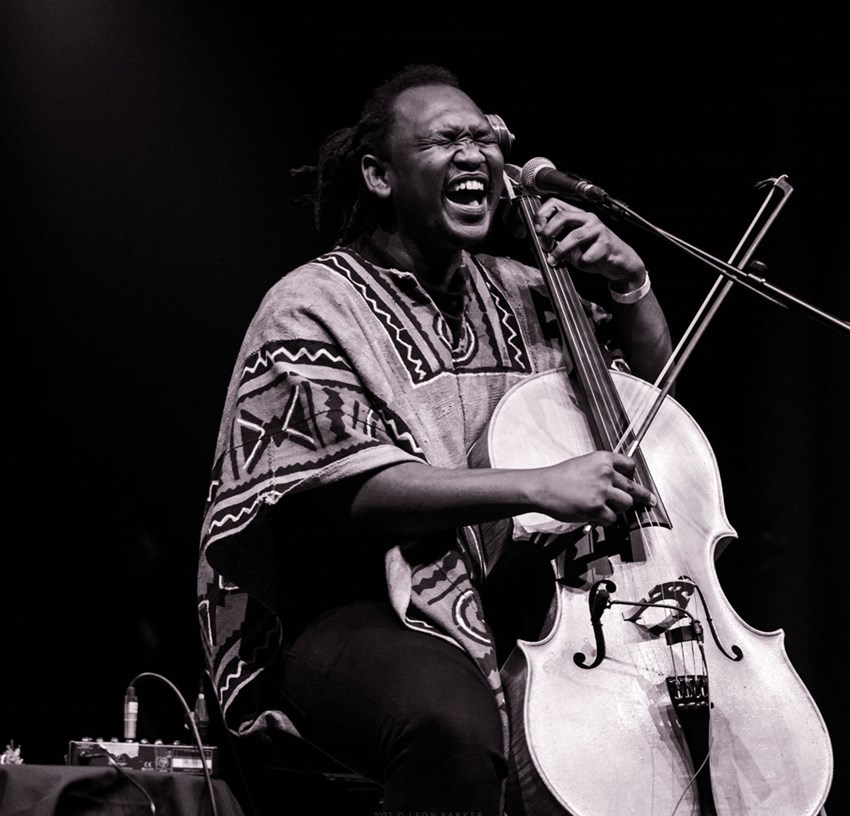Wednesday, October 26, 2022
Meeting Abel Selaocoe: “I find the threads that bind African music and classical music together”
By Jo Frost
Abel Selaocoe has made a name for himself as an innovator who straddles the worlds of Western classical and South African heritage. Jo Frost catches up with the cellist to talk about his debut solo album

Abel Selaocoe (Parlophone Records)
With his brow deeply furrowed and eyes scrunched shut in concentration, Abel Selaocoe begins to sing, his voice plaintive and soaring. Initially the focus is on his face, but then it moves to his rapid, sawing bowing then up to a blur of fingers hitting the strings. As the music builds in intensity, the voice changes, no longer soft and soulful, but deep, growling and guttural. There’s a visceral sense that the music is coursing through his entire body; as if the act of singing is a cathartic ritual. As I watch this five-minute video of Selaocoe performing ‘Lamentatio’ by the contemporary Italian cellist and composer Giovanni Sollima, I feel a rush of excitement; I really can’t recall seeing anyone play the cello – and sing – like this before. It’s my first encounter with the young and, at this point in time, relatively unknown South African cellist and I am completely captivated.
That was four years ago and, since then, Selaocoe’s profile has been on a steady upward trajectory. He’s performed at the BBC Proms (a BBC Music Introducing showcase in 2018, then a headline Prom at the Royal Albert Hall in 2021). There have also been several solo support slots (Sarathy Korwar, Ballaké Sissoko & Vincent Segal), plus numerous gigs with his Chesaba trio and the Manchester Collective, and he just performed a solo set at WOMAD in July. Regardless of the line-up or location, the Selaocoe live experience is consistently thrilling.

Abel Selaocoe (Parlophone Records)
Regular readers of Songlines will already be familiar with Selaocoe’s name (pronounced Se-lau-chay) as he’s cropped up in these pages numerous times over the last few years, with his band Kabantu, then his collaboration with the percussionist Bernhard Schimpelsberger in 2019. But it’s safe to say that we’re going to be hearing lots more about him now that he’s releasing his debut album on Warner Classics. Called Where Is Home (Hae Ke Kae in his native Sesotho language), the album showcases Selaocoe’s own compositions alongside those of some of his favourite classical baroque composers. It’s a highly personal piece of work that features many of the musicians who have accompanied him on his journey over the last few years, and it beautifully reflects the nature of an artist who is constantly challenging himself and transcends categorisation.
Watch Abel Selaocoe on Later with Jools Holland:
The idea of home is a subject that has clearly been at the forefront of Selaocoe’s music-making since moving to Manchester in 2010 to study at the Royal Northern College of Music. So, I wonder, does Manchester feel like home? There’s a lengthy pause, before he responds. “Umm, that’s a really interesting question! It feels like home because of the community I’ve been able to form. Hae Ke Kae is not the idea of a geographical space, but of a place of empowerment. It’s so good when you realise you’re in a place that fulfils your potential, comforts you, or sometimes can be hard on you – you know, this is my community.”
Selaocoe grew up in Sebokeng, a large township south of Johannesburg that, like Manchester, boasts a thriving artistic community. During his childhood, there was a big emphasis on church-going and “getting as much inhalation of spirituality as possible.” But it was his brother Sammy, a bassoonist and saxophonist, who was most influential in his pursuit of music. “He’s the one who led the way for the most part in terms of exploring the worlds of African music while living in the classical world.” After initially learning the recorder and flute, Selaocoe settled on the cello and went to ACOSA, a classical music school in Soweto. He then got a scholarship to study at the RNCM and arrived in Manchester, aged just 17. “I was young, fresh and excited,” he remembers. “I was spending a lot of time practising concertos and focusing on classical techniques, and at that point the ancestral memory was still at the back of the soul, it hadn’t come forward yet.”
This idea of ancestry informing one’s path recurs time and again during our conversation, especially when Selaocoe reflects on his singing. “I believe most of us have an ancestral memory that goes back without you even knowing… Your movement, the things you say, all of this stuff feels for me ancestral, so the voice is one of those things. I don’t sing like my brother or my mother, so it’s something that [comes] before them.”

Abel Selaocoe (photo: Leon Barker)
There was, he says, a lot of soul-searching for his own identity in those early days at the RNCM. “Everybody plays cello really well… I started to wonder who I was in this cacophony of incredible cellists.” Selaocoe first saw the aforementioned Giovanni Sollima perform while at the RNCM and it proved to be a key moment. “He’s one of the role models who emphasised that improvisation is inherent in the world of the cello. If you look as far back to baroque times, to incredible composers like Boccherini, Rameau… these guys were the rock stars of their time!” Taking Sollima’s advice to use his African culture, Selaocoe sought out other like-minded RNCM students who shared the same passion for music outside of the classical world and formed Kabantu. It was, he says, “a cry for a certain type of freedom, where we didn’t have music in front of us, we weren’t held by the burden of tradition… I’d been playing South African hymns and Bach in the same space, so I thought, ‘why not carry on doing that? Just because everybody here doesn’t do that, doesn’t mean you can’t do it.’ So, I started to find the threads that bind African music and classical music together.”
Another pivotal cello-playing classmate was Adam Szabo, who co-founded the trailblazing Manchester Collective along with violinist Rakhi Singh in 2016. Szabo and Singh felt frustrated by the lack of diversity in the classical world so decided they wanted to shake things up, broaden the repertoire and enhance the audience’s experience. “Adam had seen me improvise in class and after a while he thought what a great platform [the Manchester Collective] would be for me to collaborate,” remembers Selaocoe. “And it’s now become a home for me to bring my music.”
Selaocoe’s most recent collaboration with the MC was on The Oracle, which features several specially written pieces by Selaocoe, as well as works by composers ranging from Vivaldi and Picforth to Mica Levi. When they performed at the Queen Elizabeth Hall in April the atmosphere was electric, with a joyous energy emanating from all the musicians. Selaocoe uses the word mokete (a Sesotho word for a celebration or gathering of families) to describe the occasion and also his connection with the Manchester Collective. “It’s truly special,” he smiles. “We’ve spent so much time together that we now learn music by ear. It’s a really beautiful relationship and I hope it’s one that will last a long time.”
Co-founder and music director Singh agrees: “Manchester Collective is very much a sharing of cultures and people’s musical voices. Abel sees himself as a conduit for all of these messages and he has the ability to share that and bring it out of people. He’s extremely gifted, not just as a cellist but as a communicator.” Besides his Manchester Collective family, the two other musicians who Selaocoe credits with helping him find his own voice and hone his exploratory skills are his Chesaba bandmates, multi-instrumentalists Alan Keary and Sidiki Dembélé. Even though there’s not an obvious age difference, he endearingly calls them his ‘elders.’ “It’s wonderful to be around such versatile people. I believe in imitating and really learning from other people – imitating doesn’t necessarily mean duplicating, but just learning a language from your elders as a child [might].”
The long-awaited release of Where Is Home (Hae Ke Kae) feels like the culmination of many years of exploration and collaboration, while Selaocoe admits he’s taken his time “trying to crystallise my voice, especially on the solo cello front.” The album successfully entwines all the threads of Selaocoe’s classical background and his South African hymn-singing roots with ten of his own compositions alongside music by Bach and Platti.
It opens with a surprisingly quiet and meditative arrangement of the traditional hymn ‘Ibuyile i’Africa / Africa is Back’. Sung during apartheid times, the title is in the isiZulu language and there’s a sense of Selaocoe nailing his colours to the mast to say, ‘this is my view of Africa and it looks like this.’ “I wanted to start with this feeling of a hymn, because every meeting in South Africa starts and ends with a hymn. That’s the way we commune.”
One of his cello heroes, Yo-Yo Ma, guests on the track, having performed it together as part of Desmond Tutu’s special 90th birthday celebrations in October 2021. It was, says Selaocoe, a hugely significant moment for him: “Yo‑Yo was really able to get into this collaboration because of the essence of the message, that we can rethink what Africa means for ourselves and we can stand on the shoulders of giants like Tutu and still carve our own future.”
The track that perfectly encapsulates the subject of home and refuge is ‘Zawose (for Hukwe Zawose)’. It’s a song that pays tribute to the special relationship between Tanzania and South Africa during apartheid times. The inspiration for this came when Selaocoe heard ‘Mateso’ (Suffering) written by the legendary late musician Hukwe Zawose. In the song, Zawose speaks about how fortunate they are, given their neighbours in South Africa are being oppressed and how Tanzania’s doors will always be open for them. “They helped us in the most amazing ways, and a lot of people my age don’t really know that.”
A standout track, and sure-fire crowd pleaser whenever Selaocoe plays it live, is ‘Ka Bohaleng / On the Sharp Side’. The title comes from a Sesotho expression that says ‘a woman holds a knife on the sharp side.’ The spark for this originated from the sound of South African musician Madosini playing the uhadi (a traditional Xhosa musical bow). Madosini is, Selaocoe explains, “one of the last libraries of traditional music in South Africa. We were just looking for music that really inspired a sense of home and I came across this, so I started working on that rhythm. Then I thought of the saying that my father always used to elevate my mum, basically saying, ‘oh, look at you taking the initiative! You’re a woman who holds that knife on the sharp side,’ so the song came from that rhythm and hearing my father giving praise.” When Selaocoe, the Manchester Collective and Chesaba play this as the encore back in April at the QEH, there is a resounding and spontaneous standing ovation. It’s no surprise that the Southbank Centre have recently appointed Selaocoe as one of their new artists-in-residence, alongside the Manchester Collective. As Toks Dada, head of classical music at the Southbank Centre, says, he wanted the new cohort of artists to really reflect classical music in the 21st century and “Selaocoe absolutely aligns with that in the way he blends traditional Western classical music with music from his own South African heritage.” As part of his residency Selaocoe has been commissioned to write a kora and cello concerto with Seckou Keita to be performed next year with Chineke!, Europe’s first majority black and ethnically diverse orchestra.
So, plenty to look forward to. But first there’s the album launch, an occasion Selaocoe predicts will be a big celebratory mokete moment. “This will be the culmination of pretty much everybody I’ve been working with over the past years,” he says. “It’s going to be extremely exciting to be altogether in one space.” As acclaim for this terrifically talented artist grows and grows, Selaocoe has every reason to feel excited and celebrate his thoroughly deserved moment in the limelight.
This interview originally appeared in the October 2022 issue of Songlines magazine. Never miss an issue – subscribe today

